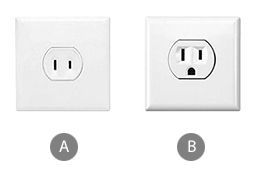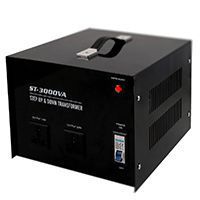Using your clothes iron in Haiti
Summary
First check your clothes iron can handle the voltage in Haiti:
- If your clothes iron can run on 110 volts or can support dual voltage (how you can tell) then you'll only need to use a suitable power adapter listed on this page if the plug on your clothes iron won't fit in the outlet.
If not then either:
- Use a dual voltage travel iron [2] - you may still need to use the right power adapter for Haiti but these cheap lightweight accessories are designed specifically for travel.
- Use a power converter (or voltage transformer) - this will enable you to use your existing clothes iron and other applicances with a 110 volt Haitian power outlet, however this is considerably heavier, bulkier and more expensive than a dedicated travel clothes iron. A power converter changes the voltage but not the physical shape of the plug on your clothes iron to fit in the wall outlet used in Haiti, therefore please check that the power converter includes an appropriate power adapter for Haiti otherwise you will need to purchase another power adapter. Also worth noting that your own personal clothes iron might not be suitable for travel and you could risk damage in your luggage. [7] [AD]
Using a clothes iron in Haiti
Will my clothes iron work in Haiti?
That will depend on if your clothes iron is designed to operate using the 110 volts which are used in Haiti. If you're using either a dual voltage clothes iron or your clothes iron is designed to operate using 110 volts and you have the appropriate plug adapter then you should be able to use the clothes iron in Haiti. If not then you will need to consider using either a power converter or a dual voltage travel iron [2]. Read the section on can you use a voltage converter to use a domestic clothes iron in Haiti for help deciding which option is more suitable. [7] [AD]
Haiti power outlets and plug sockets
What is the electrical frequency used in Haiti?
The frequency of the current from a Haitian power outlet is 60 Hz. [8]
What mains voltage is used in Haiti?
Power outlets in Haiti are 110 volts.

Type A and B power outlets
Which plug adapter will you need when using a clothes iron in Haiti?
There are two different types of power outlets used in Haiti, types B and A with the primary power outlets being type B:
- Plug Type A - You can recognise this power outlet by the two adjacent slots next to each other for live and neutral blades.
- Plug Type B - The wall socket (known as a type B power outlet) is identified by the 2 thin slots next to each other for live and neutral blades with a single hole below for the slightly long grounded pin.
A Type B power adapter will allow you to use a 110 volt clothes iron in Haiti; read the simple guide below for full details of using a clothes iron in Haiti using a power adapter. Note that unless you that have a dual voltage clothes iron you might also have to bring a power converter. [4] [9] [AD]
Dual voltage travel irons
Is my clothes iron dual voltage?
An easy way how to tell if your clothes iron supports dual voltage is to look for either a sticker or numbers printed on the plug, handle or base of your clothes iron. The location might vary depending on the make and model of your clothes iron and should also state on the box or in the instruction manual. Some dual voltage models will change automatically, however other irons will have a button or switch which allows you to change between different voltage ranges depending on which country you are in.
- Single voltage could say a specific number - such as 110V. If this number matches the 110 volts used in Haiti then you should be able to use your clothes iron with a Haitian power outlet.
- Single voltage might also have a small voltage range with a dash to accomodate small voltage fluctuations - such as 100-120V. If the 110 volts used in a Haitian power outlet falls within the range shown on your clothes iron then you should be able to use it in Haiti.
- Dual voltage will say a larger voltage range separated with a slash - such as 100/240V. Your clothes iron will be capable of being used in Haiti or any other country if these numbers are shown.
Travelling to Haiti with a clothes iron
Can you bring a clothes iron in your carry on hand luggage to Haiti?
According to the TSA guidelines for clothes irons there are no restrictions when bringing a mains powered clothes iron in your carry on hand luggage through airport security in the US. The TSA also suggests that you should verify that your airline who is taking you to Haiti will allow a clothes iron onboard and that it will fit in the overhead bin or underneath the seat of the airplane. The TSA also recommends wrapping cords tightly around electronic items. If you do intend to pack a fragile or expensive clothes iron in your hand held luggage then it is advisable to bring hard carry on luggage as this provides the most protection against knocks and drops during your journey. [10] [11] [AD]
Power converters for Haiti

Voltage converter
What is the difference between a voltage converter and a power adapter?
A heavy and bulky power converter will convert a 110 volt Haitian power outlet to work with a non-110 volt clothes iron, but a more lightweight and cheaper power adapter (or plug adapter) will change the shape of the plug on your clothes iron to slot into a power outlet found in Haiti. [7] [AD]
Can you use your clothes iron with a converter for Haiti?
A voltage transformer (or power converter) allows a clothes iron using a different voltage to operate using a 110 volt power outlet used in Haiti. Travellers wishing to bring their own clothes iron can use a power converter, but it could be more expensive to buy a power converter than it is to purchase a dedicated dual voltage travel iron [2]. Also, a power converter is noticeably bulkier than a travel clothes iron making a power converter less suitable for packing. [7] [AD]
How to use a clothes iron in Haiti using a type B power adapter
A page showing how to use a clothes iron in Haiti using a Type B travel charger.
- Please check that your iron is either a dual voltage travel iron [2] or is compatible with a 110 volt power outlet - if not then do not proceed as you might create an electrical fire hazard, blow a fuse or damage your iron. Before using a dual voltage travel iron make sure the switch is set to accept 110 volts; please refer to the manufacturers instructions for more information on how to do this.
- If the shape of the power outlet which is used in Haiti won't accomodate the plug shape on your clothes iron you will need to use a Type B power adapter [4]. This plug adapter will help fit plugs from other countries into an electrical outlet found in Haiti by changing the shape of the plug, however it doesn't change the voltage of the clothes iron to work with a 110 volt outlet.
- Begin the process by plugging the Type B power adapter into the power outlet. The wall outlet (technically called the Type B power outlet [3]) is identified by the 2 thin slots next to each other where the short twin plug outlet blades slide into with a semicircle hole below for the earth pin.
- Plug in the clothes iron into the Type B power adapter.
- Switch on the Haitian power outlet. The clothes iron can now be used in Haiti. [AD]
How to use a clothes iron in Haiti using a type A power adapter
How to power your clothes iron in Haiti with a 2 pronged Type A power adapter.
- Please check that your iron is either a dual voltage travel iron [2] or is compatible with a 110 volt power outlet - if not then do not proceed as you may create an electrical fire hazard, damage your iron or blow a fuse. Some dual voltage irons might typically have a switch to toggle between voltages, before using the iron ensure you have set it to the 110 volt setting, please refer to the user guide for more information on how to do this.
- Please check that you don't already own a clothes iron with a Type A plug - if it does then you won't need a power adapter (but still check that your clothes iron will work with a 110 volt power outlet). If the shape of the power outlet which is used in Haiti won't accomodate the plug shape on your clothes iron you will need to use a Type A power adapter [6]. This plug adapter will help fit different plugs on appliances from other countries into an electrical outlet found in Haiti by changing the shape of the plug, however it doesn't change the voltage of the clothes iron to work with a 110 volt outlet.
- Begin the process by plugging the Type A power adapter into the power outlet. The wall outlet (technically called the Type A power outlet [5]) is identified by the 2 thin slots next to each other where the short twin plug outlet blades slide into.
- Then plug in your clothes iron into the Type A power adapter.
- Turn on the Haitian power outlet.
- Your clothes iron should now be ready to use. [AD]
See also
External links
We endeavour to ensure that links on this page are periodically checked and correct for suitability. This website may receive commissions for purchases made through links on this page. As an Amazon Associate WikiConnections earn from qualifying purchases. For more details please read the disclaimers page.
- Wikipedia - Wikipedia entry about Haiti
- Amazon - dual voltage travel iron
- iec.ch - Type B power outlet
- Type B power adapter - A Type B adapter, rated at 15 A and 125 V, featuring two parallel flat blades and a longer grounding pin, in compliance with NEMA 5-15 specifications. Suitable for travel to the US plug types and Canadian plugs..
- iec.ch - Type A power outlet
- Type A power adapter - A two-blade, ungrounded electrical plug adapter for US plug types, Canadian power outlets, Thailand sockets, Mexico plug types, and select Asian power outlets..
- Power converter - Heavy-duty power converters are designed to convert voltage levels between different electrical standards, shifting between 110V/120V and 220V/240V with both 50Hz and 60Hz, often incorporating safety features such as fuse protection and circuit breakers..
- Wikipedia - WikiPedia - Mains electricity by country -
- iec.ch - IEC World Plugs by location -
- tsa.gov - TSA guidelines for clothes irons -
- Hard carry on luggage - Hard carry-on luggage features a tough outer shell to absorb impact and is recommended for transporting heat tools or fragile electronics in overhead bins..
| 2 other devices in this category | |
| Connecting a Haitian power outlet to: |
|